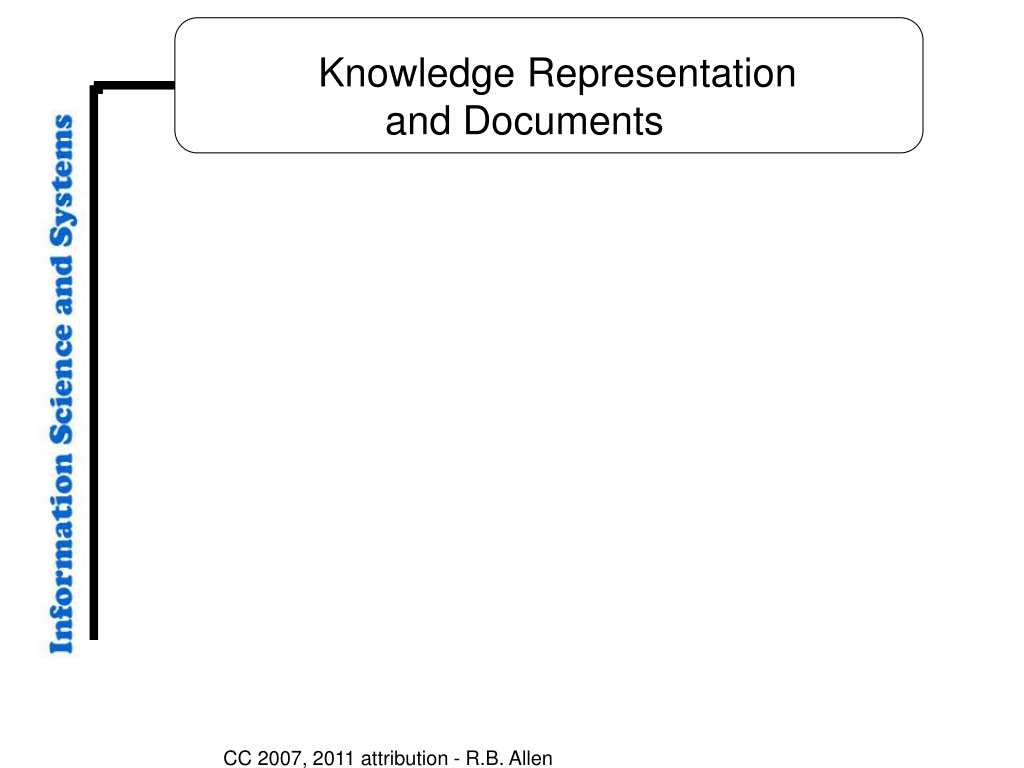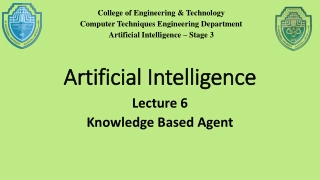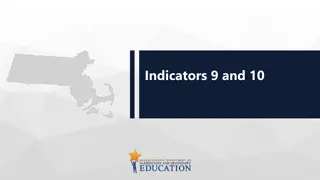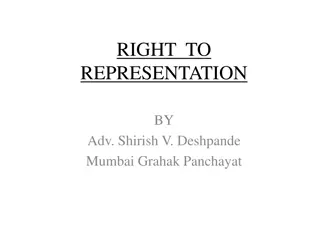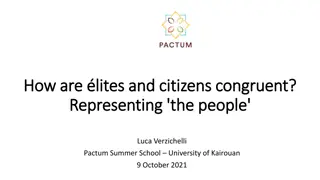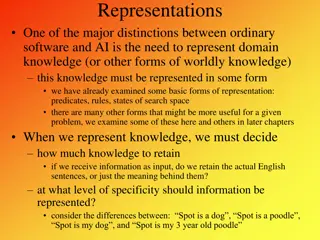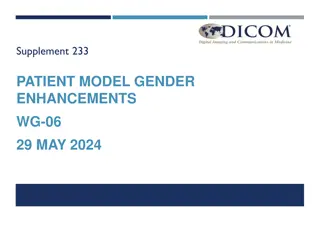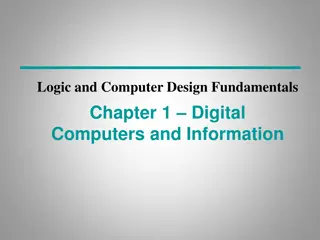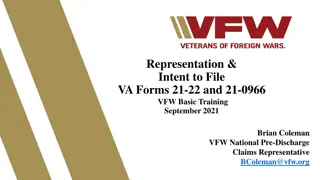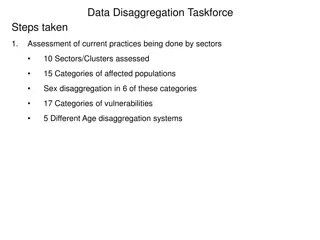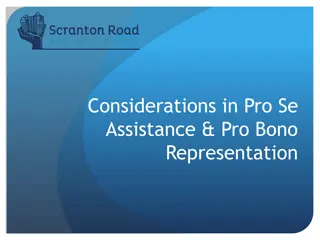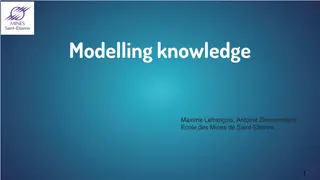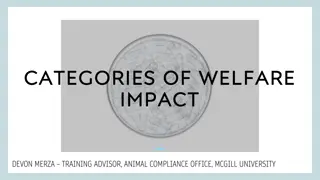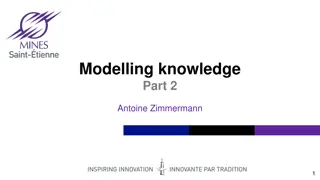Understanding Knowledge Representation and Categories in Information Systems
Exploring various types of representations and categories, this content delves into Aristotle's classical view of categories, the contrast between Aristotle's empirical approach and Plato's Ideals, the concept of prototypes, and different models for categorization. It highlights how entities are classified in information systems based on Aristotelian categories.
Download Presentation

Please find below an Image/Link to download the presentation.
The content on the website is provided AS IS for your information and personal use only. It may not be sold, licensed, or shared on other websites without obtaining consent from the author. Download presentation by click this link. If you encounter any issues during the download, it is possible that the publisher has removed the file from their server.
E N D
Presentation Transcript
Knowledge Representation and Documents CC 2007, 2011 attribution - R.B. Allen
Representations There are many types of representations. The phrase knowledge representation is most often associated with logic, but we use it s broader sense. Nonetheless, we focus here on simple symbolic categorical representations. They are the basis for most database systems. CC 2007, 2011 attribution - R.B. Allen
Aristotelian Categories Categories are defined by a combination (conjunction) of attributes A bird: Has wings Has two Legs Is hot-blooded Aristotle proposed this classical view of categories. CC 2007, 2011 attribution - R.B. Allen
Aristotle vs. Plato Detail from Raphael s School of Athens Aristotle (right) is empirical. His categories are based on entities having specific attributes. This is the basis of science. He gestures towards the earth. Plato (left) proposed Platonic Ideals (prototypes or overall concepts). He is shown pointing to the sky. CC 2007, 2011 attribution - R.B. Allen
Prototypes Categories can be characterized by similarity to a prototype. A bird could be assigned to a category based on its similarity to an ideal concept of bird-ness . Thus, a sparrow is a good example of a bird and a penguin is a poor example. A bat might be confused for a bird. Plato came up with this alternative to Aristotle. CC 2007, 2011 attribution - R.B. Allen
How do we assign data to Categories? On the left the groups of attributes can be separated by a linear partition. On the right, no linear partition is possible. CC 2007, 2011 attribution - R.B. Allen
Other Models for Categories Functional categories Can a tree-branch be a chair? Continuous categories Can we define attributes for colors? Abstract categories What are the attributes of beauty ? Radial categories Is a step-mother a mother? Family resemblance categories There doesn t seem to a single set of attributes to define a game . Rather it s a family resemblance (disjunction of conjuncts) CC 2007, 2011 attribution - R.B. Allen
Categories and Information Systems Aristotelian categories are usually assumed when developing databases. If entities must be classified into one or another category, there may be a representational bias such that unique aspects of some entities may not be well captured. CC 2007, 2011 attribution - R.B. Allen
Data Schema and Metadata Real-world objects are a bundle of attributes. To describe them we create a schema. Schema.org is developing schemas for many entities on the Web (e.g., pizza joints, computer parts) We also often want to describe information resources. For those we develop metadata CC 2007, 2011 attribution - R.B. Allen
Metadata Systems Dublin Core (Web pages) Bibliographic metadata (books) Latest system is FRBR Functional Requirements for Bibliographic Records Archival metadata CC 2007, 2011 attribution - R.B. Allen
Authority Files and Application Profiles Comprehensive metadata systems are accompanied by: Authority files which list valid entries for some fields (e.g., lists of people who are authors) Application profiles which describe to types of applications for which a given metadata system should be used. CC 2007, 2011 attribution - R.B. Allen
Classification System A distinction may be made between a category and a class. A classification is based on some principle, or model. Classification systems are used to describe the subject or topic of an information resource in a metadata system Classification systems are often hierarchical. These can be taxonomies when applied to biological classification. CC 2007, 2011 attribution - R.B. Allen
Controlled Vocabularies Consider all the terms we use to describe a car auto, automobile, beetle, bucket*, bug, buggy, bus, clunker, compact, convertible, conveyance, coupe, hardtop, hatchback, heap, jalopy, jeep, junker, limousine, machine, motor, motorcar, pickup, ride, roadster, sedan, station wagon, subcompact, touring car, truck, van, wagon, wheels, wreck A controlled vocabulary would give us a single specific term This is useful for making clear specifications and for retrieval CC 2007, 2011 attribution - R.B. Allen
Thesaurus Vehicle BT (broader term) RT ST Van Car Auto (broader term) (synonymous term) NT (narrower term) Sedan Describe the relationship among terms using only very general relationships. CC 2007, 2011 attribution - R.B. Allen
Ontologies Ontologies are rich descriptions of a domain. Essentially, they try to create an Aristotelian data model to cover an entire domain. That is, the entities, attributes, classes, and relationships are all identified exactly. They allow reasoning with formal logic. drives on Uses fuel road car gasoline Ontologies are the basis of knowledge-bases and the Semantic Web Thesauri and Ontologies provide strikingly different ways of describing domains. Ontologies try to be exact, whereas Thesauri are approximate. CC 2007, 2011 attribution - R.B. Allen
Data Models Data Models Compressed representations of entities, attributes, and relationships We will consider three in this course Entity-Relationship Model Relational Data Model Object-Oriented Model Also includes descriptions of behavior with methods Described in later in course. CC 2007, 2011 attribution - R.B. Allen
Entity-Relationship (ER) Data Model CC 2007, 2011 attribution - R.B. Allen
Relational Data Model Basis of Access, MySQL, and Oracle. Entities and attributes are organized into tables. Not as conceptually elegant as the ER model, but its easy to implement. Most large database implementations such as airline reservation systems and university student record systems use the Relational Model. CC 2007, 2011 attribution - R.B. Allen
More on the Relational Data Model The tables are linked by the Dept ID. This saves having to repeat details like Dept Location for each Employee. Employee DeptID Phone Email DeptID Dept Name Location SQL (the Structured Query Language) is a query language for relational databases. CC 2007, 2011 attribution - R.B. Allen
Databases and Information Systems We will see the object-oriented data model next week. Data models are applied in databases and database management systems. When dealing with database management systems, we need to be concerned with factors such as security, reliability, and data integrity. CC 2007, 2011 attribution - R.B. Allen
Neural Network Representations While Databases and Knowledge-bases use entities and classes for knowledge representation, purely statistical representations are also possible. For instance, Neural Networks are to model complex human learning and reasoning with simple neurons and synapses . CC 2007, 2011 attribution - R.B. Allen
